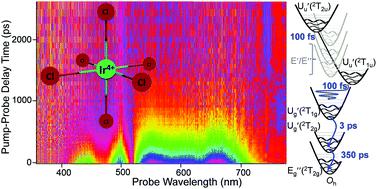当前位置:
X-MOL 学术
›
Phys. Chem. Chem. Phys.
›
论文详情
Our official English website, www.x-mol.net, welcomes your
feedback! (Note: you will need to create a separate account there.)
Ultrafast dynamics in LMCT and intraconfigurational excited states in hexahaloiridates(iv), models for heavy transition metal complexes and building blocks of quantum correlated materials.
Physical Chemistry Chemical Physics ( IF 2.9 ) Pub Date : 2020-06-22 , DOI: 10.1039/d0cp00438c Darya S Budkina 1 , Firew T Gemeda , Sergey M Matveev , Alexander N Tarnovsky
Physical Chemistry Chemical Physics ( IF 2.9 ) Pub Date : 2020-06-22 , DOI: 10.1039/d0cp00438c Darya S Budkina 1 , Firew T Gemeda , Sergey M Matveev , Alexander N Tarnovsky
Affiliation

|
The population and structural dynamics of IrCl62− is studied in acetonitrile and aqueous solutions in comparison to isoelectronic IrBr62− using ultrafast broadband, dispersed transient absorption, with both octahedra excited with 85 fs pulses at four different wavelengths, encompassing the first seven t2g-based electronic states. Ligand-to-metal charge transfer (LMCT) 420 or 490 nm excitation of IrCl62− into Uu′(2T2u) + Eu′′(2T2u) states, superimposed due to Ham effect, or Uu′(2T1u), respectively, leads to symmetry lowering due to Jahn–Teller effect in these excited states with the subsequent 100 fs decay into Ug′(2T1g). This first LMCT state is formed vibrationally coherent in the 104 cm−1 t2g (scissor) or 243 cm−1 eg (out-of-phase-stretch) Jahn–Teller modes for the respective excitation wavelength. Direct excitation into Ug′(2T1g) at 600 nm and the intraconfigurational lowest excited Ug′(2T2g) state at 1900 nm helped to establish that Ug′(2T1g) decays via back electron transfer into Ug′(2T2g) (time constants, 3.55 ps in acetonitrile and 0.9 ps in water), and the decay of Ug′(2T2g) into the ground state is the rate-limiting relaxation step. The relaxation cascade of IrBr62− is similar with short-lived (≤100 fs) higher LMCT states, but the vibrational coherence is only observed in the Jahn–Teller t2g mode. Faster back electron transfer for IrBr62− is explained by the energy gap law. The intraconfigurational Ug′(2T2g) states, which are ∼5100 cm−1 above the ground state for both complexes, have a sub-nanosecond lifetime largely independent of the ligand nature (∼350 ps, acetonitrile).
中文翻译:

六卤代甲酸酯类化合物的LMCT超快速动力学和内部配置激发态(iv),重过渡金属配合物的模型和量子相关材料的构建基块。
使用超快宽带,分散的瞬态吸收,在八面体中以85 fs脉冲在四个不同的波长下激发的八面体,涵盖了前七个,研究了乙腈和水溶液中IrCl 6 2-的种群和结构动力学,与等电IrBr 6 2-相比。吨2克为基础的电子态。IrCl 6 2-的配体到金属的电荷转移(LMCT)420或490 nm激发成U u '(2 T 2u)+ E u ''(2 T 2u)状态,由于Ham效应或U u叠加'(2吨1u)分别由于这些激发态中的Jahn–Teller效应而导致对称性降低,随后100 fs衰减为U g ′( 2 T 1g)。对于相应的激发波长,该第一LMCT状态在104 cm -1 t 2g(剪刀)或243 cm -1 e g(异相拉伸)Jahn-Teller模式下振动相干。在600 nm处直接激发成U g ′( 2 T 1g)和在1900 nm处构内最低激发U g ′( 2 T 2g)状态有助于建立U g′(2 T 1g)通过反向电子转移到U g ′(2 T 2g)(时间常数,乙腈中3.55 ps,水中0.9 ps)衰减,U g ′(2 T 2g)衰减到地面状态是限制速率的放松步骤。IrBr 6 2-的弛豫级联与短暂的(≤100fs)较高的LMCT状态相似,但振动相干性仅在Jahn–Teller t 2g模式下观察到。能隙定律解释了IrBr 6 2-更快的反向电子转移。构内U g '(两个复合物的2 T 2g)态都比基态高约5100 cm -1,其亚纳秒寿命在很大程度上与配体性质无关(约350 ps,乙腈)。
更新日期:2020-08-05
中文翻译:

六卤代甲酸酯类化合物的LMCT超快速动力学和内部配置激发态(iv),重过渡金属配合物的模型和量子相关材料的构建基块。
使用超快宽带,分散的瞬态吸收,在八面体中以85 fs脉冲在四个不同的波长下激发的八面体,涵盖了前七个,研究了乙腈和水溶液中IrCl 6 2-的种群和结构动力学,与等电IrBr 6 2-相比。吨2克为基础的电子态。IrCl 6 2-的配体到金属的电荷转移(LMCT)420或490 nm激发成U u '(2 T 2u)+ E u ''(2 T 2u)状态,由于Ham效应或U u叠加'(2吨1u)分别由于这些激发态中的Jahn–Teller效应而导致对称性降低,随后100 fs衰减为U g ′( 2 T 1g)。对于相应的激发波长,该第一LMCT状态在104 cm -1 t 2g(剪刀)或243 cm -1 e g(异相拉伸)Jahn-Teller模式下振动相干。在600 nm处直接激发成U g ′( 2 T 1g)和在1900 nm处构内最低激发U g ′( 2 T 2g)状态有助于建立U g′(2 T 1g)通过反向电子转移到U g ′(2 T 2g)(时间常数,乙腈中3.55 ps,水中0.9 ps)衰减,U g ′(2 T 2g)衰减到地面状态是限制速率的放松步骤。IrBr 6 2-的弛豫级联与短暂的(≤100fs)较高的LMCT状态相似,但振动相干性仅在Jahn–Teller t 2g模式下观察到。能隙定律解释了IrBr 6 2-更快的反向电子转移。构内U g '(两个复合物的2 T 2g)态都比基态高约5100 cm -1,其亚纳秒寿命在很大程度上与配体性质无关(约350 ps,乙腈)。











































 京公网安备 11010802027423号
京公网安备 11010802027423号